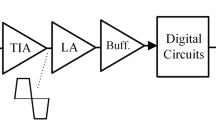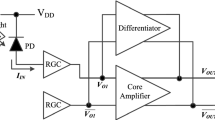Abstract
A fully differential transimpedance amplifier (TIA) with integrated differential photodetector in standard CMOS technologies has been realized for optical receivers in optical communications and optical interconnects. And a novel, fully differential photodetector aiming to convert the incident light into a pair of fully differential photo-generated currents and ensure the differential symmetry on circuit configuration and model has also been proposed for the differential TIA to achieve the fully differential characteristic. Theoretical analysis and simulation results both indicate that the fully differential TIA reaches a higher bandwidth than a conventional one and at the same time a doubled sensitivity. Based on this new TIA, a monolithic, fully differential optoelectronic integrated receiver was designed and implemented in a Chartered 3.3 V, 0.35 μm standard CMOS process. It demonstrates 98.75 dBΩ transimpedance gain, and 0.334 μA equivalent input integrated referred noise current from 1 Hz up to −3 dB frequency. The power dissipation from a single 3.3 V supply is 100 mW for the TIA-LIA (limiting amplifier)-combination plus 138 mW for the 50 ω output buffer. At 850 nm wavelength, the optical receiver achieves a 1.1 GHz 3 dB bandwidth, and can handle bitrates up to 1.6 Gbit/s for −12.2 dBm peak-peak optical power and 231−1 PRBS (pseudorandom bit sequency) input signal.
Similar content being viewed by others
References
Hermans C, Tavernier F, Steyaert M. A gigabit optical receiver with monolithically integrated photodiode in 0.18 μm CMOS. In: Proceedings of the 32nd European Solid-State Circuits Conference (ESSCIRC), Montreux, Switzerland, 2006. 476–479
Hermans C, Michiel S J. A high-speed 850-nm optical receiver front-end in 0.18 μm CMOS. IEEE J Solid-State Circ, 2006, 41: 1606–1614
Jutzi M, Grözing M, Gaugler E, et al. 2-Gb/s CMOS optical integrated receiver with a spatially modulated photodetector. IEEE Photon Tech Lett, 2005, 17: 1268–1270
Kiziloglu K, Seetharaman S, Glass K W, et al. Fully differential receiver chipset for 40 Gb/s applications using GaInAs/InP single heterojunction bipolar transistors. In: Proceedings of the 21st International Conference on Computer Design, California, America, 2003. 462–466
Razavi B. Design of Integrated Circuits for Optical Communications. New York: The McGraw-Hill Companies, Inc., 2003. 100–103
Yu C L, Mao L H, Song R L, et al. Design and implementation of an optoelectronic integrated receiver in standard CMOS process. Chin J Semiconduct, 2007, 28: 1198–1203
Razavi B. Design of Analog CMOS Integrated Circuits. New York: The McGraw-Hill Companies, Inc., 2001. 121–131
Johns D A, Martin K. Analog Integrated Circuit Design. New York: John Wiley & Sons, Inc., 1997. 179–182
Das M B, Chen J W, John E. Designing optoelectronic integrated circuit (OEIC) receivers for high sensitivity and maximally flat frequency response. IEEE J Lightwave Tech, 1995, 13: 1876–1884
Author information
Authors and Affiliations
Corresponding author
Rights and permissions
About this article
Cite this article
Yu, C., Mao, L., Xiao, X. et al. A fully differential transimpedance amplifier with integrated differential photodetector in standard CMOS process for optical communications and interconnects. Sci. China Inf. Sci. 54, 1300–1311 (2011). https://doi.org/10.1007/s11432-010-4142-2
Received:
Accepted:
Published:
Issue Date:
DOI: https://doi.org/10.1007/s11432-010-4142-2




